The Schlossberg caves in Homburg, Germany, are technically not caves, but a system of Medieval mining tunnels! What were they mining? Gold? Copper? Precious gems? Nope… would you believe, sand? The cave system is actually Europe’s largest red sandstone cave system, and while it sounds odd to mine sand, the high quartz content made that sand perfect for glass production! The sand that wasn’t suitable for glass was used as foundry sand in iron production, and even as a kind of industrial grit used to scour wooden floors.
Lost and forgotten for centuries, the top three levels of this fascinating man-made cave system are now open to the public!
Here’s a video of our adventure underground, with all the details to follow in the blog post below!
History of Schlossberg Caves
Medieval Tunnels and Sand Mine
‘Schlossberg’ means ‘castle mountain’ in German, and the cave system stretches underneath what was once an impressive Medieval castle fortress on a hill. It is believed that the original Schlossberg cave passages served as defensive escape routes from the castle. A clever secret escape!

And soon their utilitarian functions were discovered. The yellowish quartz-filled sandstone layers yielded glass making material, while the red was used in the iron foundry and as an abrasive.
French Occupation
The lands of the German/French border regions have often changed hands over the centuries. After the French occupation of Homburg (from 1649-1714) which followed the Thirty Years War, the cave system was expanded and used for storage. They found out quickly, though, that the very high humidity in the Schlossberg caves made them unsuitable to store food or gunpowder.
Forgotten Caves
When mining ended, the Schlossberg caves were forgotten until the 1930s when a young boy from the town discovered them again. The story says that he fell down a hole into one of the many chambers. In the ensuing decade during World War II the newly discovered caves were made use of again. During Allied air raids of the town, residents would take shelter in the cave system until the bombing stopped. Some people lived in the Schlossberg caves for weeks at a time.
Post-War Era
In the mid-1950s the cave was expanded again to add a large bricked bunker. This was to serve as a government bunker but when Saarland was re-affiliated to the new German government in 1957, construction ceased.
By the 1960s there were regularly-held events and cave festivals inside the tunnels. One exceptionally large chamber is known as “The Throne Room.” When I heard this, my imagination went full-Tolkien, transported to the Great Hall of Thráin, imagining dragons and treasure and the ancient throne beneath the mountain… But it turns out that during one of the festivals in the 60s they would party here and elect a “Cave Queen” who would sit on the throne in the throne room. I have to say it was a little bit of a letdown.
Modern Day Fortifications

To protect cave-goers from falling rocks (!) the Schlossberg caves underwent a major fortification effort between 2003 and 2007. Using steel reinforcements, the latest mining technology, and a whopping 3 million Euros, they have now ensured your trip to the Schlossberg caves will be safe and secure. The reinforcements, almost shaped like gothic arches, also add to the fascinating atmosphere of the cave system.
Visiting Schlossberg Caves
Access
The Schlossberg caves are open from April to October, from 9am to 5pm, and November to March from 10-4, seven days a week. **The caves are closed in December and January.
To access the Schlossberg caves you will need to either go up or down a lot of stairs, depending on whether you come from the top of the hill or the bottom. There are also stairs within the cave. You don’t have to go up to the top two levels inside the cave, but there’s no getting out of the stairs to the entrance.

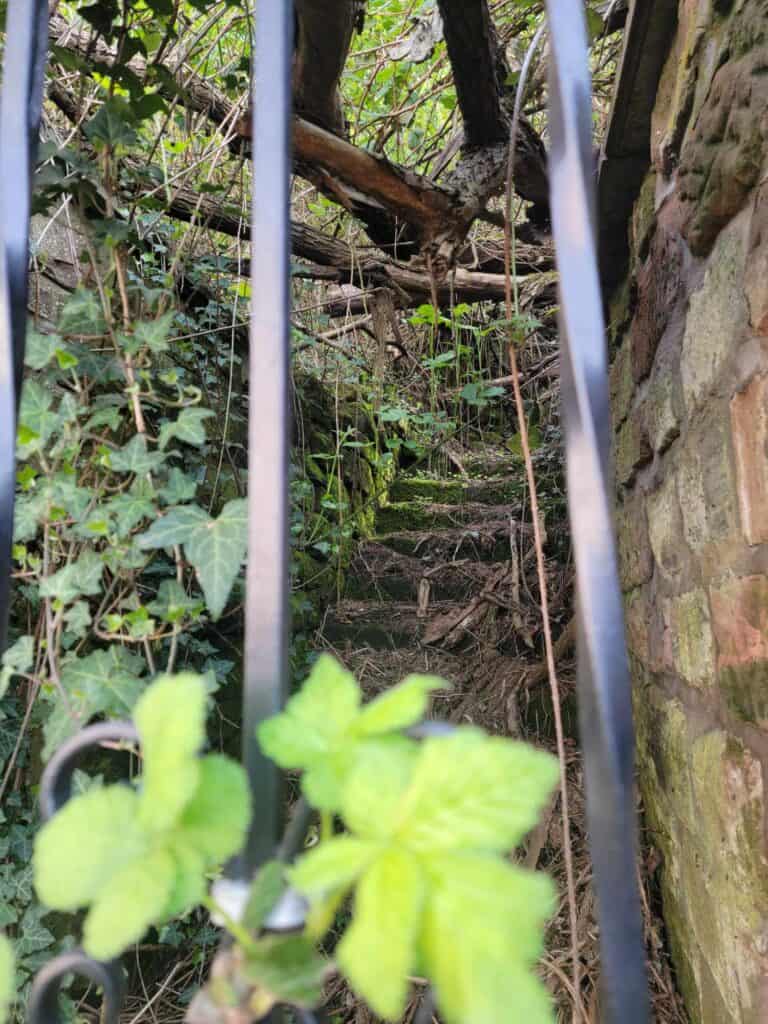

The good news is that the stairs from the bottom only take about five minutes, and have spacers inbetween. It’s about the same from the top but the stairs are steeper with less space between.
Size and structure
There are 8 caverns, or chambers, inside the three levels accessible by the public. The 9 lower levels remain inaccessible, but there may possibly be plans to expand access in the future. You’ll enter on the third level with the option of walking up a set of metal stairs to two levels above.
There are more than 3 miles of tunnels total, and about a half mile is available to the public to walk through.
How to Dress
The Schlossberg caves are a fairly constant 50 degrees Fahrenheit (10 degrees Celsius), and about 80-100% humidity. To have a good look around, you’ll need about 45 minutes to an hour. I was fine with a long sleeved shirt and lightweight pants, but you may want to bring a light jacket if you are not used to chilly weather. We went in April, but I couldn’t help thinking how lovely this would be on a hot July or August day!
Parking
There is nearby parking at the bottom of the hill (with stairs leading up to the cave) or at the top of the hill (with stairs going down to the cave). Parking below is on the street and free. Parking above is next to the castle walls and is also free.
Admission to Schlossberg Caves
Tickets are 7 Euros for adults, and 5 Euros for students. There are also special rates and group discounts at the official Schlossberg Caves website.

There are a few souvenirs available for purchase, including a shot glass, magnets, and a flask with an image of the cave ghost. Also a bag of mini pretzels!
Safety


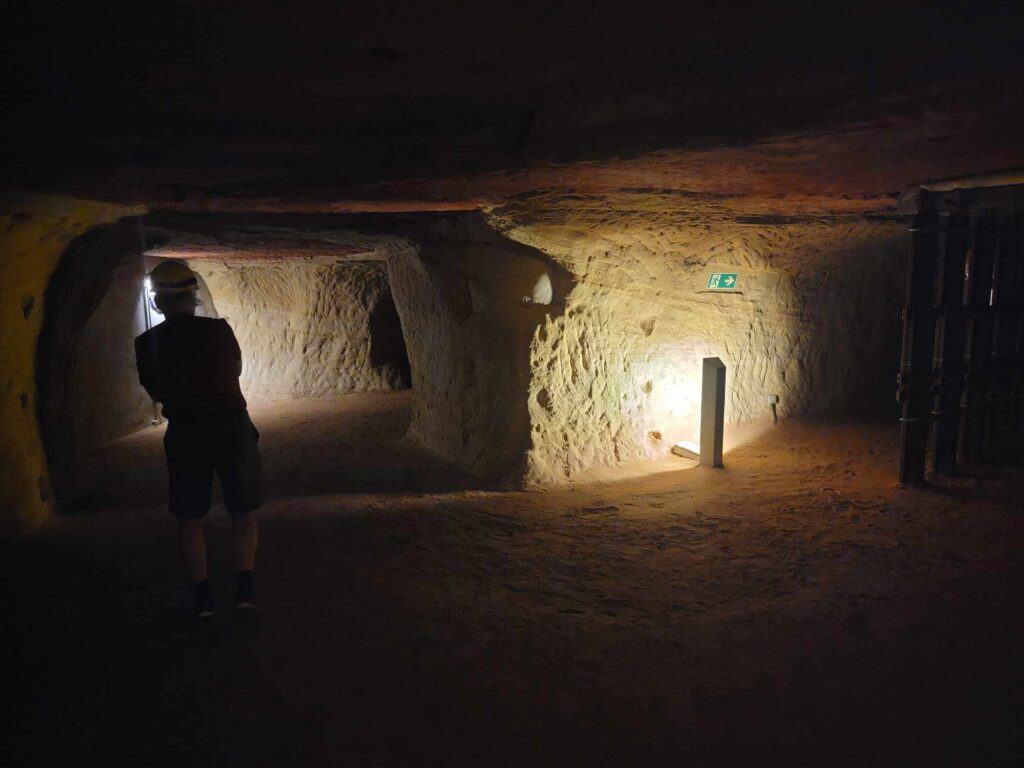


At the ticket desk, you’ll get a hair net which goes on underneath the yellow helmets provided in a large bin on your way into the Schlossberg caves. The helmets also come with a light for emergency situations. First aid stations and emergency call buttons are located throughout the cave system, and there is also an emergency exit on the uppermost level.
Finding Your Way
You will be provided with a map at the ticket counter. It shows all the various regions of the cave system and tells information about each. English maps are available, and the signage in the cave itself is in both German and English.
You definitely won’t get lost, but it feels like you’re in a labyrinth with lots of twists and turns and false tunnels. A really fun sensation.
Things to see in Schlossberg Caves








Model of Schlossberg Caves and Castle
There’s a little diorama in a lucite case which you’ll see soon after you enter the caves. It will clearly show you how the castle is situated on top of the hill and the cave system burrows into the side, with the town of Homburg below. The replica shows the area during the Middle Ages.

Lizard footprint fossils
I can’t tell you how long we stood at the two stations that told about lizard footprint fossils looking for what they were talking about. We gave up on the first one, but on the second one we realized eventually that the giant green button was to turn on a light which showed exactly where they were. Doh!
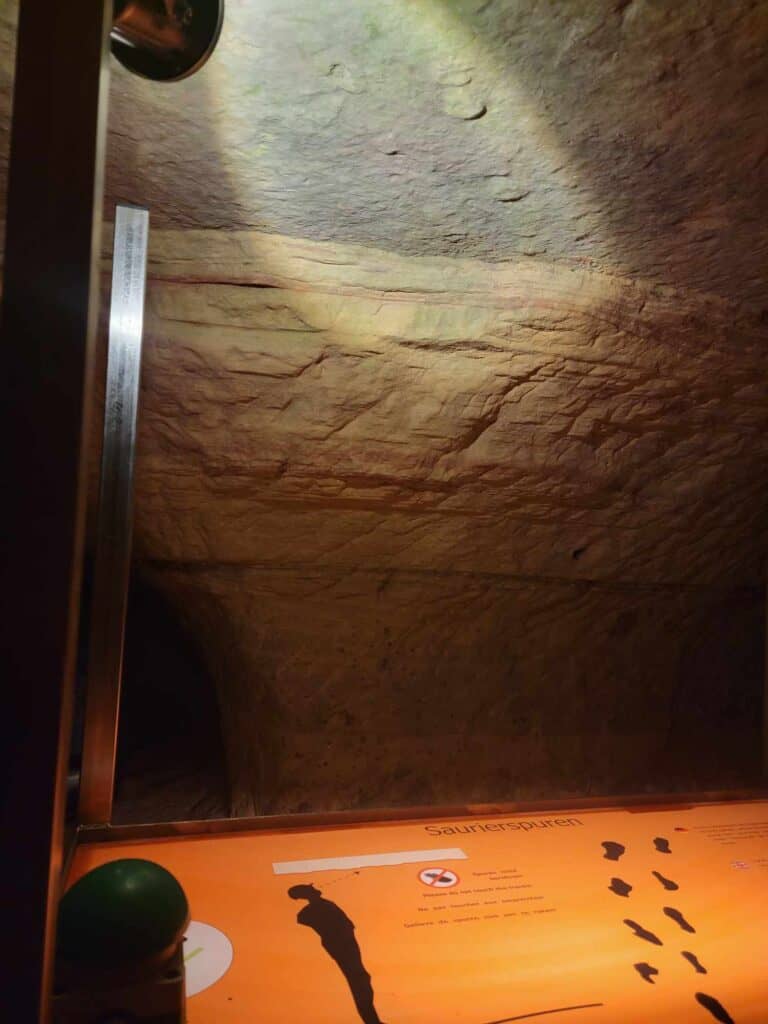

The coolest thing about these fossils are that first, they are pre-dinosaurs existing! And second, you are looking at the footprint from below so the fossil is actually convex and not concave like fossil footprints (or any footprints) we are used to seeing. It’s crazy to picture a little lizard 250 million years ago, running across the early Triassic desert, only to have homo sapiens one day looking at its footprints from underneath. Amazing!
Shaft
You will see the shaft that goes waaaaay down to the other 9 levels you can’t get to. It’s covered with a sturdy grill and you really can’t see very far down, but it’s there!
Mood lighting
Sometimes you’ll push one of those green buttons and see a area light up purple, or blue, revealing interesting visual aspects of the cave.
Chambers and supports
The chambers are just stunning. Erosion over the centuries has turned the ceilings into ringed domes, highlighting the sedimentary layers and making huge bullseye patterns.
Dog-friendliness
Dogs are allowed in the Schlossberg caves! That said, they should of course be well-behaved and kept on a leash. And definitely bring a poop bag!
Once you have been through the tour of the Schlossberg caves you can walk up to the Hohenburg castle ruins which lie right above the caves and offer a spectacular view of Homburg.
Tips for Visiting Schlossberg Caves:
- Bring cash which is the preferred method of payment
- Bring hand sanitizer. You’ll be using a bunch of hand rails in parts of the cave
- Don’t wear white shoes. You’ll pretty much be walking on moist red sand.
- Don’t bring a baby stroller. Again, red sand and also stairs.
- If you have a respiratory condition, you may want to keep your visit shorter. I have asthma and always notice that cave situations can cause minor difficulty.
- Always push the big green buttons so you don’t miss special things that need light!
- It looks like the first tour buses show up at about 11am, so if you go early, you may have the caves to yourself like we did!
Where are the Schlossberg Caves?
🚗 Homburg by car:
- 2 hours southwest of Frankfurt
- 1.5 hours southeast of Luxembourg City
- 1 hour 50 minutes north of Strasbourg
- 30 minutes southwest of Kaiserslautern
- 2.5 hours northwest of Stuttgart
🚉 Homburg by train:
- 1 hour 50 minutes from Frankfurt
- 1 hour 45 minutes from Luxembourg City
- 2 hours 20 minutes from Strasbourg
- 20 minutes from Kaiserslautern
- 2 hours from Stuttgart
Homburg Castle Ruins
How do you get to the Homburg Castle from the Schlossberg Caves?
When you leave the caves, turn right and keep going up! There’s about another 5 minutes of stairs and you will be at the top. You’ll pop out right in front of the Schlossberg Hotel and you may think you’re in the wrong spot. You aren’t!

Turn left and walk past the hotel and you will soon see a parking area and a high stone wall in front of you. Keep walking and you’ll be at the entrance.
Parking
There is free parking available right next to the ruins. Just follow the signs. If you start your journey this way it will be down stairs to the caves from there.
History
During the 1100s the castle was the seat of the counts of Homburg. After the last Count of Homburg died in 1449 Homburg and its castle fell to the counts of Nassau-Saarbrucken who rebuilt the castle. They gave it a shiny new makeover and turned it into a Renaissance palace, and then into a fortress.

In the 1600s, Homburg’s expansionist neighbor King Louis XIV got his hands on the castle, and with the help of his master builder Vauban, the castle was expanded even further. The basic structure of Homburg’s old town dates back to this time.
As hostilities were winding down and peace was declared between the Holy Roman Empire and France, the castle and fortifications were demolished and eventually in the late 1700s the ruin served as a quarry for the construction of Karlsberg Castle to the east of Homburg. Karlsberg Castle, the residence of the Duke of Zweibrücken, was at the time the largest country palace of Europe, until… The french showed up again and revolutionary troops demolished it in 1793. If those stones could talk!
Beginning in the 1980s, whatever was left of the castle underwent extensive excavation, and became the tourist-friendly ruins it is today.
Access
There are some crazy stairs to get to the top of the fortress! Narrow steep circular stairs, stairs with a rise of almost a foot, worn uneven sandstone stairs – this place has them all! If you have mobility issues, you may want to take a hard pass, or stick with the far end of the complex where you can park at a second parking area and walk around the bridgehead, the moat, and a protected footpath.
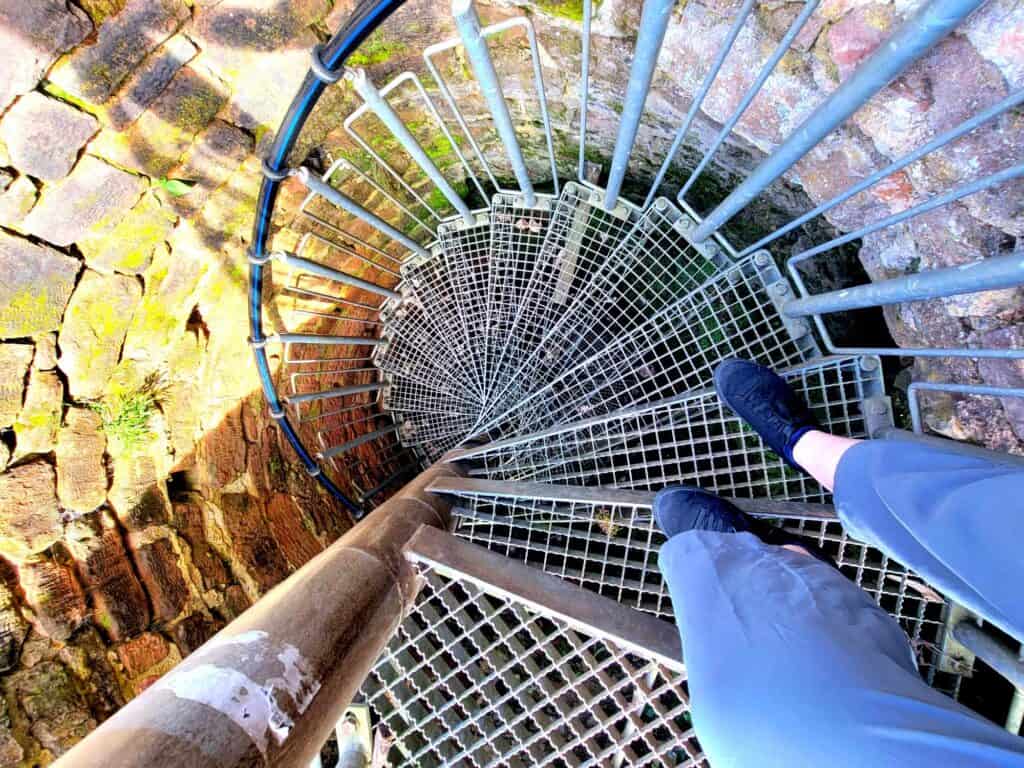


Admission to the castle is free!
What You’ll See at Homburg Castle Ruins
As you wander around the ruins, the experience is signposted, although not consistently, in German, English, and French. It’s always good to have the Google Translate app at the ready so you can point your camera and get at least a moderately good translation.



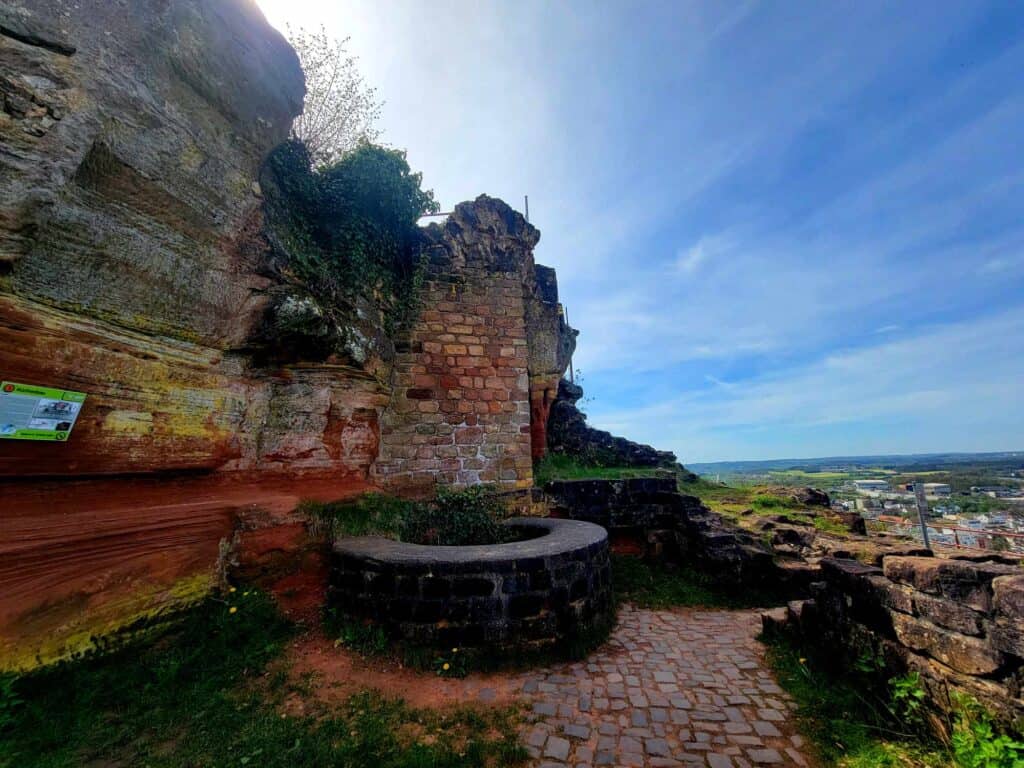




The signs have “you are here” maps to show you where you are in the complex, and color coding to explain when each part you visit was built.
And while the most interesting parts of the castle do not survive, you can still see foundation walls, some original flooring, part of the moat, water channels, the cistern, part of the kitchen, the well, and several other buildings.



When you get to the very top, there is an open flat viewing area with stunning views of the surrounding area. You’ll see (and hear) the whole town of Homburg below. The flag of Homburg and the German flag fly, and there is also a set of binoculars which takes 1 Euro coins and allows you to check out the details of the city and surrounding area.
We’d heard mention that there have been issues with broken bottles, trash, and graffiti at the site. We did see graffiti, unfortunately, but everything else looked in pretty good shape.
I was curious to see if you’d be able to see where the secret tunnels were that led from the castle into the Schlossberg caves underneath, but I didn’t see anything marked.
How Much Time Do You Ned at Homburg Castle?
Of course, it depends on how long you want to stay, and if you really want to explore every corner of the castle, or whether your goal is just to get to the top and survey the kingdom. I’d say give it at least an hour to get a good feeling for the main part of the castle, get some pictures, read some signage and get back down. Add another half hour or so to go visit the far end of the castle where the moat and other fortifications are.
Pair your trip to the castle with the Schlossberg caves, exploring the market square, and a leisurely lunch and you’ve got a nice day!
Tips for Visiting Homburg Castle
- Bring a Euro coin for the binoculars
- Bring a water bottle in the summer. There is not much shade and if it’s hot you’ll need it!
- Beware the nettles, especially if you’re in shorts. They aren’t everywhere, but there’s enough of them you’ll want to keep your eyes open!

For more interesting castle hikes, ruins, and other cool things in the area, check out these posts:
- 21 Best Things to Do in Kaiserslautern Germany
- 28 Best Day Trips from Kaiserslautern: Your Ultimate Guide
- Ultimate Guide to Frankenstein Castle in Frankenstein Germany
- Hike to Hohenecker Castle in Kaiserslautern Germany
- Explore Fascinating Nanstein Castle in Landstuhl Germany
- Stahleck Castle in Bacharach: A Gorgeous Hike with a Dark Past
- Discover Charming Hohenbaden Castle Overlooking Baden-Baden
- A Real-Life Fairytale Castle in Germany – Discover Miraculous Burg Eltz
- Saarbrücken Castle – Explore This Fascinating Underground World
- Lowenburg Castle – The Remarkable Story of a Medieval Castle that Isn’t!
- Your Ultimate Guide to Visiting Nuremberg Castle: History, Tips & Must-Sees
- Völklingen Ironworks – Comprehensive Guide for Visiting This Remarkable UNESCO Site
- Dinopark Kaiserslautern: Great Fun for Everyone!
To receive notifications when new content appears on The Adventure Lion, sign up below and join the pride!
